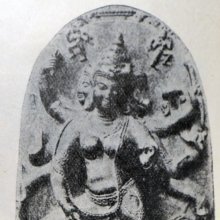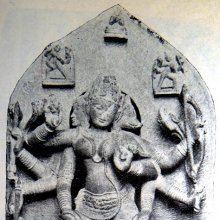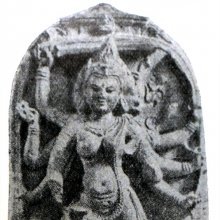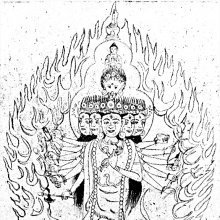Shashvata, Śāśvata: 21 definitions
Introduction:
Shashvata means something in Buddhism, Pali, Hinduism, Sanskrit, Jainism, Prakrit, Marathi, Hindi. If you want to know the exact meaning, history, etymology or English translation of this term then check out the descriptions on this page. Add your comment or reference to a book if you want to contribute to this summary article.
The Sanskrit term Śāśvata can be transliterated into English as Sasvata or Shashvata, using the IAST transliteration scheme (?).
Alternative spellings of this word include Shasvat.
Images (photo gallery)
In Hinduism
Purana and Itihasa (epic history)
Source: Cologne Digital Sanskrit Dictionaries: The Purana IndexŚāśvata (शाश्वत).—Of the south.*
- * Vāyu-purāṇa 45. 130.

The Purana (पुराण, purāṇas) refers to Sanskrit literature preserving ancient India’s vast cultural history, including historical legends, religious ceremonies, various arts and sciences. The eighteen mahapuranas total over 400,000 shlokas (metrical couplets) and date to at least several centuries BCE.
Ayurveda (science of life)
Source: gurumukhi.ru: Ayurveda glossary of termsŚāśvata (शाश्वत):—[śāśvatam] Eternal: immortal, everlasting

Āyurveda (आयुर्वेद, ayurveda) is a branch of Indian science dealing with medicine, herbalism, taxology, anatomy, surgery, alchemy and related topics. Traditional practice of Āyurveda in ancient India dates back to at least the first millenium BC. Literature is commonly written in Sanskrit using various poetic metres.
Shaktism (Shakta philosophy)
Source: Google Books: Manthanabhairavatantram1) Śāśvata (शाश्वत) refers to “eternal reality” [e.g., the eternal reality], according to the Manthānabhairavatantra, a vast sprawling work that belongs to a corpus of Tantric texts concerned with the worship of the goddess Kubjikā.—Accordingly, “[...] He is himself the knower who is liberated and is the eternal (reality) [i.e., śāśvata] at the End of Sound. In this way, O Lord, he should abandon delusion. [...]”.
2) Śāśvata (शाश्वत) or Śāśvataśūnya refers to the “eternal void”, according to the Manthānabhairavatantra.—Accordingly, “[...] (16) Above that is the eternal Void [i.e., śāśvata-śūnya—śāśvataṃ śūnyaṃ]. (There) one should think of nothing. Then, having emptied the mind (one attains) Nirvāṇa, the supreme plane. Having contemplated the End of the Nine, which is supreme, (one attains) Nirvāṇa, the supreme plane. The renouncer, having contemplated the End of the Nine, is freed from bondage. [...]”.
3) Śāśvata (शाश्वत) refers to one of the eight Bhairavas (bhairava-aṣṭaka) associated with Avyaktapīṭha (i.e., ‘the unmanifest seat’ representing the act of churning—manthāna), according to the Manthānabhairavatantra.—[...] The eight Bhairavas (bhairavāṣṭaka): Nitya, Nāda, Aja, Kāraṇa, Avyaya, Sarvaga, Śāśvata, Sthāṇu.

Shakta (शाक्त, śākta) or Shaktism (śāktism) represents a tradition of Hinduism where the Goddess (Devi) is revered and worshipped. Shakta literature includes a range of scriptures, including various Agamas and Tantras, although its roots may be traced back to the Vedas.
Shaivism (Shaiva philosophy)
Source: SOAS University of London: Protective Rites in the Netra TantraŚāśvata (शाश्वत) refers to “(one who is) eternal” and is used to describe Amṛteśa, according to the Netratantra of Kṣemarāja: a Śaiva text from the 9th century in which Śiva (Bhairava) teaches Pārvatī topics such as metaphysics, cosmology, and soteriology.—Accordingly, [verse 9.5-11, while explaining the universality of Amṛteśa]—“Amṛteśa is supreme. He is free of disease. His nature is inherent, fully enumerated, constant, eternal (śāśvata—śāśvataṃ), and immovable. [He has] no form or color, and is the highest truth. Because of that, he is omnipresent. The splendid Deva delights in all āgamas, pervades all mantras, and grants all siddhis. In this way, he is like a transparent crystal sewn onto a colored thread, always reflected with its color, [and] seeking [to] look like this and that. [...]”.

Shaiva (शैव, śaiva) or Shaivism (śaivism) represents a tradition of Hinduism worshiping Shiva as the supreme being. Closely related to Shaktism, Shaiva literature includes a range of scriptures, including Tantras, while the root of this tradition may be traced back to the ancient Vedas.
In Buddhism
Mahayana (major branch of Buddhism)
Source: Wisdom Library: Maha Prajnaparamita SastraŚāśvata (शाश्वत) refers to “eternal”, according to Mahāprajñāpāramitāśāstra (chapter 19).—Accordingly, “The Buddha is also called Lou kia pai (lokavid). Loka means world and Vid means to know. The expression thus means ‘Knower of the world’. [Question.—How does he know the world?]—[...] Finally, he knows that the world by its nature is neither eternal (śāśvata) nor non-eternal (aśāśvata), neither finite (antavat) nor infinite (ananta), neither changing (cyuta) nor unchanging (acyuta). He is not attached (abhiniviśata) to such characteristics (lakṣaṇa). Pure (viśuddha), eternal (nitya), unalterable (avipraṇaśa), [the world] is like space (ākāśasama). This is why he is called Lokavid”.
Source: academia.edu: A Study and Translation of the GaganagañjaparipṛcchāŚāśvata (शाश्वत) refers to “(the view of) eternity”, according to the Gaganagañjaparipṛcchā: the eighth chapter of the Mahāsaṃnipāta (a collection of Mahāyāna Buddhist Sūtras).—Accordingly, “Son of good family, there are eight purities of the insight (prajñā) of the Bodhisattvas. What are the eight? To with, (1) although they attain all good qualities, they do not stick to the view of eternity (śāśvata-dṛṣṭi); (2) although they strive to get rid of all bad qualities, they do not fall into the view of annihilation; (3) although they enter into dependent origination, they are not contradictory with the tolerance that all things are unborn; (4) although they illuminate four kinds of special knowledge, they are not attached to interpretation and eloquence; [...]”.

Mahayana (महायान, mahāyāna) is a major branch of Buddhism focusing on the path of a Bodhisattva (spiritual aspirants/ enlightened beings). Extant literature is vast and primarely composed in the Sanskrit language. There are many sūtras of which some of the earliest are the various Prajñāpāramitā sūtras.
In Jainism
General definition (in Jainism)
Source: archive.org: Aspects of Jaina Art and ArchitectureŚāśvata (शाश्वत).—Tīrthaṅkaras are called Śāśvata-Jinas because in every Utsarpiṇī or Avasarpiṇī era names of these four tīrthaṅkaras are always repeated and they flourish in any of the fifteen karmabhūmis.
The traditional description of these images (pratimā) is the same in all Āgama texts. These Śāśvata-pratimās are desenbed as follows: “the palms of the hands and the soles of the feet are made of gold. The nails arc made of aṅka jewels, while the delicate portion under them is of the lohitākṣa jewel. The shanks, the knees, the thighs, the limbs of the body, the navels, the nipples, and the śrīvatsa mark on the chest are all wought out of gold. The line of hair on the body, the retina of the eyes, the eye-lashes and eye-brows are made of the rista(?)-jewel, while the lips are of coral and the teeth of crystals. The inner part of the nose is of lohitākṣa jewel while the tongue, the plate, the nostrils, the cheeks, the ears and the forehead and the śrīvatsa marks are all of gold. The bones of the forehead are adamantine”.
Source: The University of Sydney: A study of the Twelve ReflectionsŚāśvata (शाश्वत) refers to “eternal”, according to the 11th century Jñānārṇava, a treatise on Jain Yoga in roughly 2200 Sanskrit verses composed by Śubhacandra.—Accordingly, “If the body were extraordinary or absolutely eternal (atyanta-śāśvata), then on account of [that] it is suitable to do a despicable action for the sake of it”.

Jainism is an Indian religion of Dharma whose doctrine revolves around harmlessness (ahimsa) towards every living being. The two major branches (Digambara and Svetambara) of Jainism stimulate self-control (or, shramana, ‘self-reliance’) and spiritual development through a path of peace for the soul to progess to the ultimate goal.
Languages of India and abroad
Marathi-English dictionary
Source: DDSA: The Aryabhusan school dictionary, Marathi-Englishśāśvata (शाश्वत).—a Everlasting; durable. f Per- petuity. Ex. hyā dēhācī śāśvata nāhīṃ mhaṇūna īśvarabhajanīṃ lāgāvēṃ.
Marathi is an Indo-European language having over 70 million native speakers people in (predominantly) Maharashtra India. Marathi, like many other Indo-Aryan languages, evolved from early forms of Prakrit, which itself is a subset of Sanskrit, one of the most ancient languages of the world.
Sanskrit dictionary
Source: DDSA: The practical Sanskrit-English dictionaryŚāśvata (शाश्वत).—a. (-tī f.)
1) [śaśvad bhavaḥ aṇ]
1) Eternal, perpetual, everlasting; शाश्वतीः समाः (śāśvatīḥ samāḥ) Rām.1.2.15 (= Uttararāmacarita 2. 5) 'for eternal years', 'ever more', 'for all time to come'; श्रेयसे शाश्वतो देवो वराहः परिकल्पताम् (śreyase śāśvato devo varāhaḥ parikalpatām) Uttararāmacarita 5.27 (v. l.); R.14.14.
2) All.
-taḥ 1 Name of Śiva.
2) Of Vyāsa.
3) The sun.
4) Name of a lexicographer.
-tam 1 Heaven.
2) Eternity, continuity.
-tam ind. Eternally, perpetually, for ever.
Source: Cologne Digital Sanskrit Dictionaries: Shabda-Sagara Sanskrit-English DictionaryŚāśvata (शाश्वत).—mfn.
(-taḥ-tī-taṃ) Eternal, perpetual. m.
(-taḥ) 1. A name of Vyasa 2. Siva. 3. The sun. n.
(-taṃ) Heaven, ether. f. (-tī) The earth. E. śaśvat perpetually, aṇ aff.
Source: Cologne Digital Sanskrit Dictionaries: Benfey Sanskrit-English DictionaryŚāśvata (शाश्वत).—i. e. śaśvant + a, I. adj., f. tī, 1. All, [Uttara Rāmacarita, 2. ed. Calc., 1862.] 36, 7; Mahābhārata 12, 9192. 2. Eternal, [Hitopadeśa] ii. [distich] 60; perpetual, Böhtl. Ind. Spr. 101 (with na, perishable); ºtam, adv. Constantly, [Mālatīmādhava, (ed. Calc.)] 3, 5. Ii. m. 1. A name of Vyāsa. 2. Śiva. 3. The sun. Iii. f. tī, The earth. Iv. n. Heaven.
Source: Cologne Digital Sanskrit Dictionaries: Cappeller Sanskrit-English DictionaryŚāśvata (शाश्वत).—[feminine] ī constant, perpetual, uninterrupted, eternal; [neuter] = seq.
Source: Cologne Digital Sanskrit Dictionaries: Aufrecht Catalogus Catalogorum1) Śāśvata (शाश्वत) as mentioned in Aufrecht’s Catalogus Catalogorum:—poet. [Subhāshitāvali by Vallabhadeva]
2) Śāśvata (शाश्वत):—Anekārthasamuccaya lex. Quoted by Kṣirasvāmin, by Vararuci Oxf. 167^a, in Gaṇaratnamahodadhi, by Medinīkara, Ujjvaladatta, Mallinātha, and others.
3) Śāśvata (शाश्वत):—Meghadūtaṭīkā.
Source: Cologne Digital Sanskrit Dictionaries: Monier-Williams Sanskrit-English Dictionary1) Śāśvata (शाश्वत):—mf(ī)n. ([from] śaśvat) eternal, constant, perpetual, all (śāśvatībhyaḥ samābhyaḥ, śāśvatīḥ samāḥ, or śāśvatam, for evermore, incessantly, eternally), [Vājasaneyi-saṃhitā] etc. etc.
2) about to happen, future, [Monier-Williams’ Sanskrit-English Dictionary]
3) m. Name of Śiva, [cf. Lexicographers, esp. such as amarasiṃha, halāyudha, hemacandra, etc.]
4) of Vyāsa, [cf. Lexicographers, esp. such as amarasiṃha, halāyudha, hemacandra, etc.]
5) of a son of Śruta (and father of Su-dhanvan), [Viṣṇu-purāṇa]
6) of a poet and various other writers ([especially] of a lexicographer, author of the Anekārtha-samuccaya)
7) n. continuity, eternity, [Mahābhārata]
8) heaven, ether, [Horace H. Wilson]
Source: Cologne Digital Sanskrit Dictionaries: Yates Sanskrit-English DictionaryŚāśvata (शाश्वत):—[(taḥ-tī-taṃ) a.] Eternal, perpetual. m. Vyāsa; Shiva f. (ī) Earth. n. Ether, sky.
Source: DDSA: Paia-sadda-mahannavo; a comprehensive Prakrit Hindi dictionary (S)Śāśvata (शाश्वत) in the Sanskrit language is related to the Prakrit word: Sāsaya.
[Sanskrit to German]
Sanskrit, also spelled संस्कृतम् (saṃskṛtam), is an ancient language of India commonly seen as the grandmother of the Indo-European language family (even English!). Closely allied with Prakrit and Pali, Sanskrit is more exhaustive in both grammar and terms and has the most extensive collection of literature in the world, greatly surpassing its sister-languages Greek and Latin.
Hindi dictionary
Source: DDSA: A practical Hindi-English dictionaryŚāśvata (शाश्वत) [Also spelled shasvat]:—(a) eternal, immortal, perpetual; permanent; ~[tā] eternity, perpetuality, immortality; permanence.
...
Kannada-English dictionary
Source: Alar: Kannada-English corpusŚāśvata (ಶಾಶ್ವತ):—[adjective] without end; everlasting; permanent; eternal.
--- OR ---
Śāśvata (ಶಾಶ್ವತ):—
1) [noun] that which is eternal.
2) [noun] the Supreme Being; the Eternal.
3) [noun] Śiva.
4) [noun] Křṣṇa Dvaipāyana, the sage who collected, classified and edited the vedas.
5) [noun] the sun.
6) [noun] the heaven.
Kannada is a Dravidian language (as opposed to the Indo-European language family) mainly spoken in the southwestern region of India.
Nepali dictionary
Source: unoes: Nepali-English DictionaryŚāśvata (शाश्वत):—adj. eternal; perpetual; everlasting; n. 1. heaven; 2. space; the universe;
Nepali is the primary language of the Nepalese people counting almost 20 million native speakers. The country of Nepal is situated in the Himalaya mountain range to the north of India.
See also (Relevant definitions)
Starts with: Shashvatadrishti, Shashvatadrishtika, Shashvatamandira, Shashvatananda, Shashvatapada, Shashvatashunya, Shashvatata, Shashvatatva, Shashvatavadin, Shashvatavajra, Shashvatoccheda.
Ends with: Ashashvata, Atyantashashvata, Chittashashvata, Cittashashvata, Parishashvata.
Full-text (+74): Ashashvata, Shashaya, Shashvatatva, Shashvati, Khudula, Parishashvata, Shashvatika, Sasata, Anekarthasamuccaya, Shashvatamandira, Meghopala, Yapaniyaka, Mahavidagdha, Shashvatendra, Abhishu, Shashvatananda, Rathodvaha, Shashvatikata, Mahabala kavi, Vyakaranatraya.
Relevant text
Search found 54 books and stories containing Shashvata, Śāśvata, Sasvata, Śaśvata; (plurals include: Shashvatas, Śāśvatas, Sasvatas, Śaśvatas). You can also click to the full overview containing English textual excerpts. Below are direct links for the most relevant articles:
Rig Veda (translation and commentary) (by H. H. Wilson)
Rig Veda 1.72.1 < [Sukta 72]
Shrimad Bhagavad-gita (by Narayana Gosvami)
Verses 10.12-13 < [Chapter 10 - Vibhūti-yoga (appreciating the opulences of the Supreme Lord)]
Verse 18.56 < [Chapter 18 - Mokṣa-yoga (the Yoga of Liberation)]
Verse 2.20 < [Chapter 2 - Sāṅkhya-yoga (Yoga through distinguishing the Soul from the Body)]
Amarakoshodghatana of Kshirasvamin (study) (by A. Yamuna Devi)
Division of Time < [Chapter 3 - Social Aspects]
Daily Life (3): Perfumes < [Chapter 3 - Social Aspects]
Fauna (8): Birds < [Chapter 5 - Aspects of Nature]
Samkhya thoughts in the Mahabharata (by Shini M.V.)
Seventeen and Eighteen Tattvas of Sāṃkhya philosophy < [Chapter 4 - Sāṃkhya thoughts in the Śānti-parva of Mahābhārata]
Sūkṣma Śarīra < [Chapter 4 - Sāṃkhya thoughts in the Śānti-parva of Mahābhārata]
The concept of Ātman < [Chapter 3 - The Philosophical Tenets in the Śānti-parva]
Bhakti-rasamrta-sindhu (by Śrīla Rūpa Gosvāmī)
Verse 1.2.139 < [Part 2 - Devotional Service in Practice (sādhana-bhakti)]
Verse 2.1.298 < [Part 1 - Ecstatic Excitants (vibhāva)]
Manusmriti with the Commentary of Medhatithi (by Ganganatha Jha)
Verse 12.123 < [Section XIII - Summing up of the Esoteric Teaching]
Verse 1.107 < [Section LXI - Results accruing from the study of the Institutes]
Verse 1.112 < [Section LXII - Contents of the Treatise]



